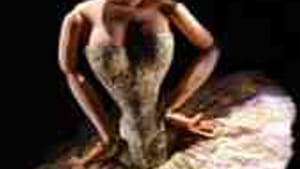Stay in the Loop
BSR publishes on a weekly schedule, with an email newsletter every Wednesday and Thursday morning. There’s no paywall, and subscribing is always free.
Who dances better than dancers?
Basil Twist's puppet "Petrushka' at Annenberg

Puppeteers are the alchemists of our age, transforming the base and inanimate materials of wood, cloth and paint into physically vibrant and emotionally driven characters. In this regard, few rival the artistry of the master puppeteer Basil Twist, whose radically revised Petrushka ballet won over Annenberg audiences of young and older during the current Philadelphia International Festival of the Arts.
This was a return to the roots of the Stravinsky-Fokine ballet that Diaghilev's Ballet Russes presented in 1911. Back then, the story of the soulful marionettes that live in a St. Petersburg Shrovetide carnival fairground was enacted by dancers who moved as if they were puppets.
But Twist's rendition reaches back to the original folk tradition that inspired the ballet. The brilliance of the production at Annenberg, created by Twist in 2001, is that he uses puppets to enact puppets.
The heart of the narrative is the love triangle between the downtrodden but spunky clown Petrushka; the strikingly alluring, pencil-thin Ballerina; and the musclebound, gold nipple-ringed Moor, who is never far from his scimitar. Twist pared the original orchestration down to two pianos set before the stage. The pianists were the identical twin Russian sisters, Julia and Irina Elkina, who played with gusto and sensitivity.
Harder than it looks
Twist's four-foot-high puppets are inspired by the Japanese Bunraku tradition, in which three puppeteers work each figure: one to direct the head and pelvis, a second the arms, and a third the feet. Twist's team for Petrushka numbered nine performers, all wizards at their craft.
Special lighting effects for the most part hide these puppet masters, who huddle together as one body in the blackness, moving laterally—and invisibly— with choreographic grace across a space no more than 20 feet wide. (A recent dance/puppet Philadelphia Dance Projects workshop I participated in with Christopher Williams, the ballet captain and Petrushka lead puppeteer here, revealed firsthand the challenges faced by the three people who must work in unison.)
The puppet Petrushka first portrays exuberant, springy movement and then succumbs to depression when rejected by the flirty Ballerina. We see him as the imprisoned victim of the all-powerful Magician, represented only by a pair of oversized white hands.
Stalinesque icon
Hilariously and poignantly, Twist decorates Petrushka's cell with a framed picture of a small human hand— a kind of Stalinesque icon. Oversized hands are a recurring motif, alluding to the fabrication of the theater work, and to the nature of the art of puppetry itself, particularly the subjugation of Petrushka.
The Ballerina, toujours en pointe, snaps off classic ballet moves, and, because she is a puppet, can do what humans can't— namely slow, soaring leaps that haughtily defy gravity and time. She's a real vamp who tries to seduce the Moor with a well-positioned derriere. (Williams, an outstanding New York-based dancer and choreographer, helped set the Ballerina's movements.)
The angered Moor's high-speed chase scene across the fairgrounds as he seeks Petrushka's head, is a masterstroke. Stravinsky's hand— or rather the four hands of the Elkina sisters— provides the dynamic chords and sonorities that energize the action and dances.
Stravinsky prelude
Twist uses hand-manipulated puppetry to present all elements of the story within a gold-filigreed picture frame surrounding the stage. The larger carnival scene is suggested by puppets in the shape of oversized flower clusters, large instruments (balalaika, drums, accordion) played by hands alone, and windblown fabrics of red and silver that move as scenery across the visual space. Petrushka's impending death is foreshadowed by a colossal, horrific puppet of a bear's head baring its sharp teeth and fierce claws, riding atop a rotating red ball.
As a prelude to the main offering of Petrushka, Twist used Stravinsky's Sonata for Two Pianos to warm the visual imagination, accompanying it with a succession of abstract geometric forms ministered by the puppeteers. In this work, as in Petrushka, the human manipulators are virtually invisible throughout, garbed head to toe in black.♦
To read a related comment by Tom Purdom, click here.
This was a return to the roots of the Stravinsky-Fokine ballet that Diaghilev's Ballet Russes presented in 1911. Back then, the story of the soulful marionettes that live in a St. Petersburg Shrovetide carnival fairground was enacted by dancers who moved as if they were puppets.
But Twist's rendition reaches back to the original folk tradition that inspired the ballet. The brilliance of the production at Annenberg, created by Twist in 2001, is that he uses puppets to enact puppets.
The heart of the narrative is the love triangle between the downtrodden but spunky clown Petrushka; the strikingly alluring, pencil-thin Ballerina; and the musclebound, gold nipple-ringed Moor, who is never far from his scimitar. Twist pared the original orchestration down to two pianos set before the stage. The pianists were the identical twin Russian sisters, Julia and Irina Elkina, who played with gusto and sensitivity.
Harder than it looks
Twist's four-foot-high puppets are inspired by the Japanese Bunraku tradition, in which three puppeteers work each figure: one to direct the head and pelvis, a second the arms, and a third the feet. Twist's team for Petrushka numbered nine performers, all wizards at their craft.
Special lighting effects for the most part hide these puppet masters, who huddle together as one body in the blackness, moving laterally—and invisibly— with choreographic grace across a space no more than 20 feet wide. (A recent dance/puppet Philadelphia Dance Projects workshop I participated in with Christopher Williams, the ballet captain and Petrushka lead puppeteer here, revealed firsthand the challenges faced by the three people who must work in unison.)
The puppet Petrushka first portrays exuberant, springy movement and then succumbs to depression when rejected by the flirty Ballerina. We see him as the imprisoned victim of the all-powerful Magician, represented only by a pair of oversized white hands.
Stalinesque icon
Hilariously and poignantly, Twist decorates Petrushka's cell with a framed picture of a small human hand— a kind of Stalinesque icon. Oversized hands are a recurring motif, alluding to the fabrication of the theater work, and to the nature of the art of puppetry itself, particularly the subjugation of Petrushka.
The Ballerina, toujours en pointe, snaps off classic ballet moves, and, because she is a puppet, can do what humans can't— namely slow, soaring leaps that haughtily defy gravity and time. She's a real vamp who tries to seduce the Moor with a well-positioned derriere. (Williams, an outstanding New York-based dancer and choreographer, helped set the Ballerina's movements.)
The angered Moor's high-speed chase scene across the fairgrounds as he seeks Petrushka's head, is a masterstroke. Stravinsky's hand— or rather the four hands of the Elkina sisters— provides the dynamic chords and sonorities that energize the action and dances.
Stravinsky prelude
Twist uses hand-manipulated puppetry to present all elements of the story within a gold-filigreed picture frame surrounding the stage. The larger carnival scene is suggested by puppets in the shape of oversized flower clusters, large instruments (balalaika, drums, accordion) played by hands alone, and windblown fabrics of red and silver that move as scenery across the visual space. Petrushka's impending death is foreshadowed by a colossal, horrific puppet of a bear's head baring its sharp teeth and fierce claws, riding atop a rotating red ball.
As a prelude to the main offering of Petrushka, Twist used Stravinsky's Sonata for Two Pianos to warm the visual imagination, accompanying it with a succession of abstract geometric forms ministered by the puppeteers. In this work, as in Petrushka, the human manipulators are virtually invisible throughout, garbed head to toe in black.♦
To read a related comment by Tom Purdom, click here.
What, When, Where
Basil Twist’s Petrushka. Through April 16, 2011 at Harold Prince Theater, Annenberg Center, 3680 Walnut St. (215) 898-3900 or www.annenbergcenter.org.
Sign up for our newsletter
All of the week's new articles, all in one place. Sign up for the free weekly BSR newsletters, and don't miss a conversation.

 Jonathan M. Stein
Jonathan M. Stein